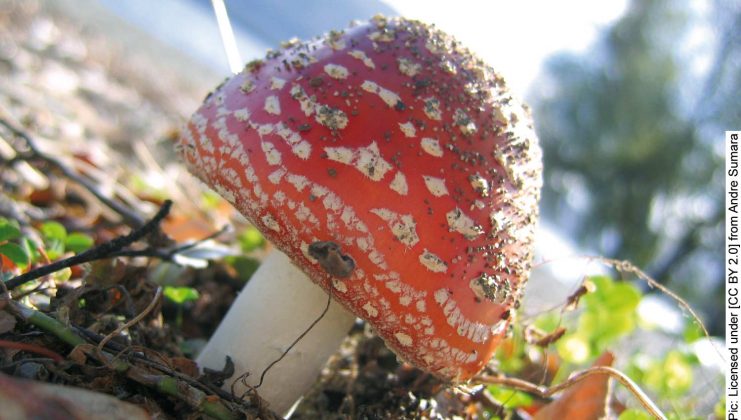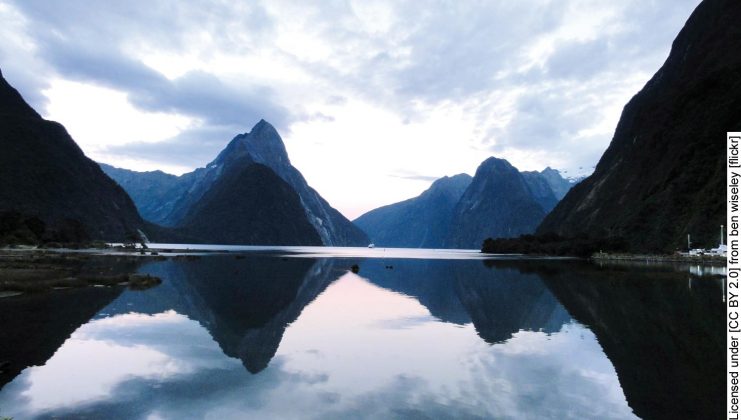Queenstown in New Zealand is a much stomped playground and from there you can travel deeper inwards and immerse yourself in the unique geographical beauty of New Zealand’s Fiordland. The national park covers 1.2 million hectares of virgin rainforest, with 14 fjords or the ‘Sounds’ carving into over 200 km of the coastline. Glaciers leaving for the Tasman Sea are carved out of granite mountains and the area has some of the best walking trails in the world.
If an adrenalin-driven sport is a challenge to nature, a gentle walk embraces nature. To stretch this weak metaphor further, an engagement with the Sounds in New Zealand’s Fiordland National Park is a long and loving one.
The Milford Trail is the oldest and, at 53 km, takes four days to cover. But don’t let that deter you—the sample walk is 11 km long and can be done in four to five hours. There are no inclines on the gentle walk to the Giant Gate falls, and you’ll still have time for a cruise up and down the Doubtful Sounds to look for seal pups.
Launch off
I start off at Queenstown, by getting on the 100-year-old steamboat TSS Earnslaw on Lake Wakatipu. My eventual destination is the lakeside town of Te Anau from where you can drive to Milford Sound, but we’re taking the long, scenic way there. The Earnslaw gives you a smooth, thoughtful look at the surrounding Remarkables mountain range on its one-and-a-half hour trip.
Instead of taking the tour, I get off at the Walter Peak High Country Farm. If you’re interested in animal farms, the tour here introduces you to the merino sheep, stags raised for their venison, the alpaca and the hefty variety of cattle. After meeting the friendly animals you can head to the homestead for scones and tea. Of all the animals in the farm, the most interesting are the hard-working sheepdogs. The others have gone ‘Pavlov’—they don’t bother to say hello, unless you are part of a large mob and have tasty nibbles for them. The sheepdogs take their job very seriously—they stare down the sheep that hide behind the alpaca as well as those who are a little slow on the uptake. No dry nibbles for these dogs. Instead, they follow you to the homestead in the hope of getting scones.
Steve Norris is my guide in this high country as we make our way to Te Anau.
The drive to Te Anau passes through acres of farmland with deer, sheep, cows—all being raised and living a near-natural life before meeting an untimely end on a thoughtfully-garnished plate. While dairy is not a big industry in this region owing to lack of the right grazing grounds, Steve tells me there have been experiments with milking deer and turning it into cheese.
We are travelling into Hobbit country and as we head deeper into Fiordland, the pine forests turn to beech. Te Anau town gets its name from the lake it’s settled around. It’s a resort town with plenty of bed and breakfasts, cafes, motels and hotels for those making their way to Milford and Doubtful Sounds. In summer, the sun stays up till 9.30 pm, so there’s enough time for a walk around the lake or a trip to the caves with their glow worm grottos.
Milford bound
Milford itself is 120 km from Te Anau, so Steve picks me up bright and early at 6.30 am. The stunning landscape more than makes up for the early wake-up call. Much of the drive is through a corridor of trees lined by Mirror Lake, whose surface the morning mist apprehensively touches. It’s three degrees Celsius outside. New Zealand and I have agreed to disagree about our definition of summer.
Just like that, the scenery changes to meadows, snow-capped peaks appear in the distance and there is a glimpse of Mt Tutoko, the highest peak in the region, still wearing its crown of snow.
Scientifically, the Sounds were carved by glaciers gliding into the Tasman sea; mythologically, they were carved by a Maori demigod who looked back and saw how wonderful his work was. Then, to ensure that people didn’t loiter here, he created the annoying sand-flies to keep them moving.
If you want to stay closer to the destination, Milford Sound Lodge is the last accommodation in the national reserve. It has camping grounds, dorm rooms, trailer parking and independent bungalows. They also have an opening for three volunteers each season who can earn their lodging and boarding by working there four hours a day.
The Sounds
In the pioneer times of the 1890s, the Sounds served as a prison. Cordoned off by the sea and rivers, inmates served their time by levelling off the tracks. Anna is our guide for the day—an unassuming young girl given to verbalising internal monologues. In a way, she’s the prototype of young kiwis. A quick seven-minute boat ride from the mainland drops us off into the Sound; us being three couples of varying ages and nationalities, a Brazilian whose enthusiasm powers us forward and myself.
Anna introduces us to the varieties of fern—the coral-like umbrella moss, the dog-tongue fern that proliferates by dividing its leaf; the chicken and hen fern whose saplings manifest with roots on the leaf and then drop off into a welcoming soil; the old man’s beard that purifies and cools an already robustly oxygenated air; the antiseptic ferns used in World War II as bandages. There’s also a steady sampling of berries, spicy leaves and an identification of leaves that can be a laxative. She’s quick to recognise the tomtit, takahe or tui.
When we come to the clear stream that runs under Giant Gate, sadness strums my heart. The stream floor is visible from the bridge—the water is as clear as an infant’s conscience, but chilling as a voice in a dark room. I want to plunge in, however there is no way to enjoy it but from the shore. As I watch the gurgling stream with a warm cup of coffee in my hand, I realise that this magnificent view will have to do.
What else can I do?
The Milford Sound Cruise
To explore the Sound by water, hop on board a cruise ship. The trip lasts one hour 40-minutes and if you go in January or February, there is a chance of spotting newly born sea lions. You can book your spot and request a Hindu vegetarian meal at www.realjourneys.co.nz.
Visit the glow worm caves
On the Te Anau lake, a two-hour cruise takes you inside a network of caves that is 12,000 years old. A quick explanation about the life cycle of the glow worm and you are put on a punt to see the glow worm grottos. At some places, the ceiling of the cave is so thin, you can see the sky through the cracks made by tenacious roots. [www.realjourneys.co.nz]
Watch Ata Whenua
Ata Whenua or Shadowland is the Maori name for Fiorland. After you’ve seen the fiords by boat and on foot, complete the experience by seeing them through the air at the Fiordland Cinema built expressly for viewing this wordless documentary [there are no distracting subtitles or commentary]. The 32-minute movie was produced and made by local helicopter pilot Kim Hollows and gives an overview of the region through different seasons. Go in with a glass of wine. [www.fiordlandcinema.co.nz]
How do I get there?
The tours to Milford Sounds are conducted by local guide companies such as Trips and Tramps [www.tripsandtramps.com]. There are shuttle services from Te Anau, as well as Queenstown twice a day.
This was first published in the June 2014 issue of Complete Wellbeing.








